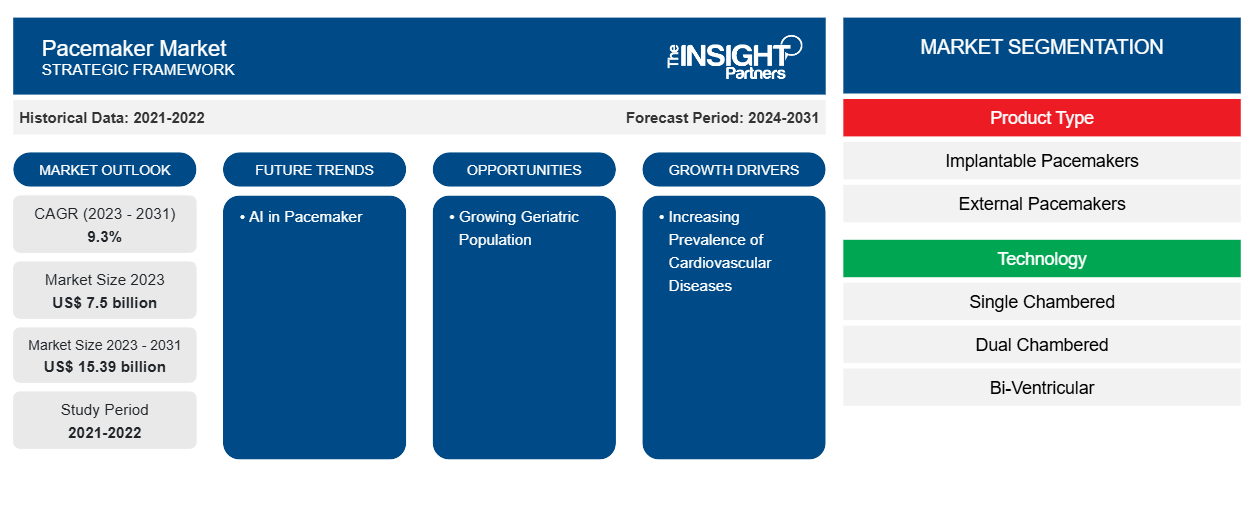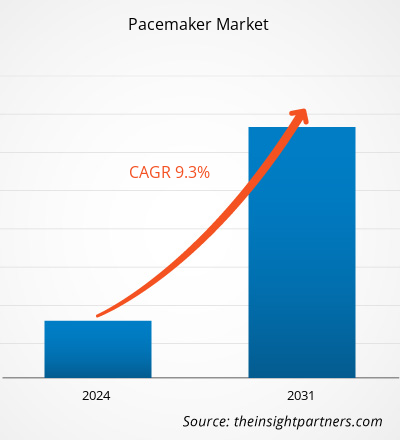The Pacemaker Market size was estimated to be US$ 7.5 billion in 2023 and is expected to reach US$ 15.39 billion by 2031; it is estimated to record a CAGR of 9.3% till 2031. Strategic developments and product launches are likely to remain key Pacemaker Market trends.
Pacemaker Market Analysis
The key factor that are responsible for the growth of market include increasing government support, technological advancements, growing geriatric population, increasing preference for minimally invasive surgical procedure, growing awareness about advanced pacemakers, and favourable reimbursement policies. In addition, increasing research and development activities in the field of pacemakers is fueling the growth of the pacemaker market.
Pacemaker Market Overview
Pacemakers are advised for medical conditions such as, bradycardia and heart block. A pacemaker is also suggested for the geriatric population, as normal aging of the heart may disrupt the normal heart rate, making it beat too slowly. Certain pacemakers also come along with sensors that detect body motion or breathing rate and signals the pacemaker to increase heart rate during exercise to meet the body's increased need for blood and oxygen.
Customize This Report To Suit Your Requirement
You will get customization on any report - free of charge - including parts of this report, or country-level analysis, Excel Data pack, as well as avail great offers and discounts for start-ups & universities
Pacemaker Market: Strategic Insights

-
Get Top Key Market Trends of this report.This FREE sample will include data analysis, ranging from market trends to estimates and forecasts.
Pacemaker Market Drivers and Opportunities
Increasing Prevalence of Cardiovascular Diseases
CVDs are a group of disorders of the heart and blood vessels and include coronary heart disease, cerebrovascular disease, rheumatic heart disease and other conditions. According to the World Health Organization (WHO), CVD is the leading cause of death globally, taking about 17.9 million lives every year. In addition, more than four out of five CVD deaths are due to heart attacks and strokes, and one third of these deaths occur prematurely in people under 70 years of age. According to Centers for Disease Control and Prevention (CDC), 1 person dies every 33 seconds in the US from cardiovascular diseases and ~695,000 people in the US died due to heart disease. As per the same source, about 805,000 people in the US suffer from heart attack every year. Thus, increase in prevalence cardiovascular diseases and increase in number of people dying due to these CVDs is fueling the growth of pacemaker market.
Use of Artificial Intelligence with Pacemaker – An Opportunity of Pacemaker Market
Artificial Intelligence (AI) has the potential to revolutionize the field of cardiology, including the management of patients with pacemakers. AI can analyze data from the pacemaker, such as heart rhythm patterns and activity level, to personalize the programming of the device for each individual patient. With the help of AI the device’s settings can be optimized and can improve overall performance. AI-powered remote monitoring systems can continuously track data from pacemaker and transmit it to the healthcare providers in real-time. This enables proactive management of patients, reduce the need for in-person clinic visits, and allow early detection of issue that may require medical assistance. Thus, benefits of use of AI in monitoring the pacemaker functioning is creating opportunity for growth of the pacemaker market.
Pacemaker Market Report Segmentation Analysis
Key segments that contributed to the derivation of the Pacemaker Market analysis are solutions, mode of delivery, application, and end user.
- Based on product type, the Pacemaker Market is segmented into implantable pacemakers and external pacemakers. The implantable pacemakers segment held the largest market share in 2023.
- By technology, the Pacemaker Market is segmented into single chambered, dual chambered, and bi-ventricular. The single chambered segment held the largest market share in 2023.
- Based on end user, the Pacemaker Market is segmented into hospitals, ambulatory surgical centers, and others. The hospitals segment held the largest market share in 2023.
Pacemaker Market Share Analysis by Geography
The geographic scope of the Pacemaker Market report is mainly divided into five regions: North America, Asia Pacific, Europe, Middle East & Africa, and South & Central America.
North America has dominated the Pacemaker Market. The growth in North America is characterized by rising geriatric population, increasing occurrence of cardiovascular and neurological diseases, high accessibility to advanced technologies, growing development of innovative and technologically advanced products, and increasing healthcare expenditure. Collaborations and robust R&D activities has also led to stimulate the growth of the market. In addition, growing focus on development of micropacemakers which can be used in infants is also driving the growth of the North America pacemaker market. Moreover, Asia Pacific is anticipated to record the highest CAGR in the coming years.
Pacemaker Market Regional InsightsThe regional trends and factors influencing the Pacemaker Market throughout the forecast period have been thoroughly explained by the analysts at The Insight Partners. This section also discusses Pacemaker Market segments and geography across North America, Europe, Asia Pacific, Middle East and Africa, and South and Central America.
Pacemaker Market Report Scope
| Report Attribute | Details |
|---|---|
| Market size in 2023 | US$ 7.5 billion |
| Market Size by 2031 | US$ 15.39 billion |
| Global CAGR (2023 - 2031) | 9.3% |
| Historical Data | 2021-2022 |
| Forecast period | 2024-2031 |
| Segments Covered |
By Product Type
|
| Regions and Countries Covered |
North America
|
| Market leaders and key company profiles |
|
Pacemaker Market Players Density: Understanding Its Impact on Business Dynamics
The Pacemaker Market is growing rapidly, driven by increasing end-user demand due to factors such as evolving consumer preferences, technological advancements, and greater awareness of the product's benefits. As demand rises, businesses are expanding their offerings, innovating to meet consumer needs, and capitalizing on emerging trends, which further fuels market growth.

- Get the Pacemaker Market top key players overview
Pacemaker Market News and Recent Developments
The Pacemaker Market is evaluated by gathering qualitative and quantitative data post primary and secondary research, which includes important corporate publications, association data, and databases. The following is a list of developments in the market for neurointerventional devices and strategies:
- Medtronic received CE (Conformité Européenne) Mark for its Micra AV2 and Micra VR2, the next generation of its industry-leading miniature, leadless pacemakers. Micra AV2 and Micra VR2, the world's smallest pacemakers, provide longer battery life and easier programming than prior Micra pacemakers, while still delivering the many benefits of leadless pacing such as reduced complications compared to traditional pacemakers. (Source: Medtronic, Company Website, 2024)
- The U.S. Food and Drug Administration (FDA) has approved the AVEIR™ dual chamber (DR) leadless pacemaker system, manufactured by Abbott, is the world's first dual chamber leadless pacing system that treats people with abnormal or slow heart rhythms. (Source: Abbott, Company Website, 2023)
- MicroPort CRM received FDA approval for its latest range of implantable pacemakers, AlizeaTM and CeleaTM, the longest-lasting pacemakers for their size. (Source: MicroPort Scientific Corporation, Company Website, 2023)
Pacemaker Market Report Coverage and Deliverables
The “Pacemaker Market Size and Forecast (2021–2031)” report provides a detailed analysis of the market covering below areas:
- Market size and forecast at global, regional, and country levels for all the key market segments covered under the scope
- Market dynamics such as drivers, restraints, and key opportunities
- Key future trends
- Detailed PEST/Porter’s Five Forces and SWOT analysis
- Global and regional market analysis covering key market trends, major players, regulations, and recent market developments
- Industry landscape and competition analysis covering market concentration, heat map analysis, prominent players, and recent developments
- Detailed company profiles
- Historical Analysis (2 Years), Base Year, Forecast (7 Years) with CAGR
- PEST and SWOT Analysis
- Market Size Value / Volume - Global, Regional, Country
- Industry and Competitive Landscape
- Excel Dataset
Recent Reports
Testimonials
Reason to Buy
- Informed Decision-Making
- Understanding Market Dynamics
- Competitive Analysis
- Identifying Emerging Markets
- Customer Insights
- Market Forecasts
- Risk Mitigation
- Boosting Operational Efficiency
- Strategic Planning
- Investment Justification
- Tracking Industry Innovations
- Aligning with Regulatory Trends





















 Get Free Sample For
Get Free Sample For